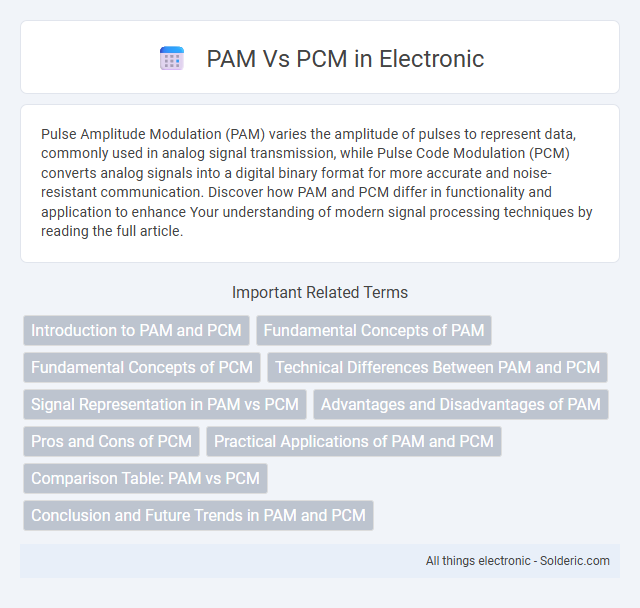Pulse Amplitude Modulation (PAM) varies the amplitude of pulses to represent data, commonly used in analog signal transmission, while Pulse Code Modulation (PCM) converts analog signals into a digital binary format for more accurate and noise-resistant communication. Discover how PAM and PCM differ in functionality and application to enhance Your understanding of modern signal processing techniques by reading the full article.
Comparison Table
| Feature | PAM (Pulse Amplitude Modulation) | PCM (Pulse Code Modulation) |
|---|---|---|
| Definition | Analog signal modulation by varying pulse amplitudes. | Digital representation of analog signals using binary code. |
| Signal Type | Analog | Digital |
| Modulation Method | Amplitude variation of pulses proportionate to signal amplitude. | Sampling, quantizing, and encoding of signal into binary form. |
| Noise Immunity | Low; prone to noise and distortion. | High; resistant to noise and errors due to digital encoding. |
| Bandwidth Requirement | Lower bandwidth than PCM. | Higher bandwidth due to digital data transmission. |
| Complexity | Simple implementation. | More complex encoding and decoding process. |
| Applications | Basic analog signal transmission, some audio systems. | Telecommunications, digital audio, and video systems. |
| Data Format | Continuous amplitude pulses. | Discrete binary codes. |
Introduction to PAM and PCM
Pulse Amplitude Modulation (PAM) and Pulse Code Modulation (PCM) are fundamental techniques used in digital communication systems to represent analog signals. PAM encodes information by varying the amplitude of pulses in proportion to the signal's instantaneous amplitude, while PCM converts the analog signal into a binary code through sampling, quantization, and encoding processes. Understanding these modulation methods improves your ability to analyze signal transmission and optimize communication system performance.
Fundamental Concepts of PAM
Pulse Amplitude Modulation (PAM) encodes information by varying the amplitude of each pulse in a regular time sequence, making it a foundational technique for analog and digital signal transmission. PAM signals represent data through discrete amplitude levels corresponding to signal values at specific sampling intervals, enabling straightforward multiplexing and demultiplexing in communication systems. Your understanding of PAM's amplitude-based encoding is crucial for comparing it with Pulse Code Modulation (PCM), which instead uses quantized digital representations of the signal amplitude.
Fundamental Concepts of PCM
Pulse Code Modulation (PCM) encodes analog signals into a digital binary format by sampling the signal amplitude at uniform intervals and quantizing these samples into discrete values. Unlike Pulse Amplitude Modulation (PAM), which varies the amplitude of pulses directly to represent the signal, PCM transforms each sample into a fixed-length binary code, enhancing noise immunity and enabling error detection. The fundamental concept of PCM revolves around three key processes: sampling, quantization, and encoding, which ensure accurate representation and efficient transmission of analog signals in digital communication systems.
Technical Differences Between PAM and PCM
Pulse Amplitude Modulation (PAM) transmits analog signals by varying the amplitude of pulses in direct proportion to the signal's instantaneous amplitude, resulting in a continuous amplitude spectrum. Pulse Code Modulation (PCM) converts the analog signal into a discrete digital bitstream through sampling, quantization, and binary encoding, enabling noise-resistant digital transmission. While PAM retains analog amplitude information susceptible to noise, PCM provides enhanced signal integrity and error correction capabilities due to its digital representation.
Signal Representation in PAM vs PCM
Pulse Amplitude Modulation (PAM) represents signals by varying the amplitude of pulses in direct proportion to the analog signal's instantaneous amplitude, producing a continuous range of amplitude values. In contrast, Pulse Code Modulation (PCM) converts the analog signal into a discrete digital form by sampling the signal amplitude at regular intervals and encoding each sample into a binary code. The key distinction lies in PAM's analog pulse amplitude variation versus PCM's digital quantization and binary signal representation, which enhances noise immunity and signal integrity in digital communication systems.
Advantages and Disadvantages of PAM
Pulse Amplitude Modulation (PAM) offers advantages such as simpler implementation, higher bandwidth efficiency, and easier signal processing compared to Pulse Code Modulation (PCM). However, PAM is more susceptible to noise and distortion, resulting in lower signal-to-noise ratio (SNR) and reduced robustness in long-distance communication. PCM provides better noise immunity and error detection but requires more complex encoding and higher bandwidth.
Pros and Cons of PCM
Pulse Code Modulation (PCM) offers high noise immunity and digital compatibility, making it ideal for modern communication systems where data integrity is crucial. It enables efficient compression and encryption, enhancing security and bandwidth utilization. However, PCM requires more complex hardware and greater bandwidth compared to Pulse Amplitude Modulation (PAM), which can increase system cost and power consumption.
Practical Applications of PAM and PCM
Pulse Amplitude Modulation (PAM) is widely used in digital communication systems for encoding data into amplitude variations, making it ideal for Ethernet networks and optical fiber transmissions. Pulse Code Modulation (PCM) is predominantly employed in telephony and audio recording, converting analog signals into digital format for precise signal reproduction and noise reduction. Both techniques enable efficient data transmission, but PCM's digital encoding offers greater robustness against noise compared to PAM's analog amplitude variations.
Comparison Table: PAM vs PCM
Pulse Amplitude Modulation (PAM) transmits analog signals by varying pulse amplitudes, while Pulse Code Modulation (PCM) digitizes the signal into binary form for higher noise immunity. A comparison table highlights PAM's simplicity and susceptibility to noise against PCM's complex encoding with enhanced signal integrity. Your choice depends on system requirements for accuracy, noise tolerance, and bandwidth consumption.
Conclusion and Future Trends in PAM and PCM
Pulse Amplitude Modulation (PAM) and Pulse Code Modulation (PCM) differ significantly in signal representation, with PAM using analog amplitude variations and PCM employing digital encoding for enhanced noise resistance. Future trends indicate a shift towards PCM due to its superior performance in digital communication systems and integration with advanced compression and error correction algorithms. Emerging applications in 5G networks and IoT further drive research towards optimizing PCM for higher data rates and energy efficiency while PAM retains niche roles in simpler or analog-dominant systems.
PAM vs PCM Infographic

 solderic.com
solderic.com